Fescn2 Study guides, Class notes & Summaries
Looking for the best study guides, study notes and summaries about Fescn2? On this page you'll find 8 study documents about Fescn2.
All 8 results
Sort by
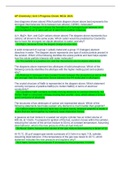
-
AP Chemistry | Unit 3 Progress Check: MCQ: 2023.
- Exam (elaborations) • 5 pages • 2023
-
- $7.99
- + learn more
AP Chemistry | Unit 3 Progress Check: MCQ: 2023. (two diagrams shown above) Which particle diagram shown above best represents the strongest intermolecular force between two ethanol, C2H6O, molecules? (Li+, Mg2+, Na+, and Ca2+ cations shown above) The diagram above represents four cations, all shown to the same scale. Which cation would be predicted by Coulomb's law to have the strongest ion-dipole attraction to water, and why? A solid compound of a group 1 (alkali) metal and a group 1...
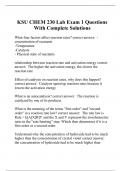
-
KSU CHEM 230 Lab Exam 1 Questions With Complete Solutions
- Exam (elaborations) • 2 pages • 2023
- Available in package deal
-
- $9.49
- + learn more
What four factors affect reaction rates? correct answer: -concentration of reactants -Temperature -Catalysts - Physical state of reactants relationship between reaction rate and activation energy correct answer: The higher the activation energy, the slower the reaction rate Effect of catalysts on reaction rates, why does this happen? correct answer: Catalysts speed up reaction rates because it lowers the activation energy What is an autocatalysis? correct answer: The reaction ...
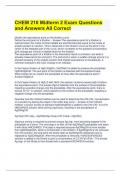
-
CHEM 210 Midterm 2 Exam Questions and Answers All Correct
- Exam (elaborations) • 10 pages • 2024
-
Available in package deal
-
- $9.99
- + learn more
CHEM 210 Midterm 2 Exam Questions and Answers All Correct Identify the equivalence point on the titration curve. Define the end point of a titration. - Answer-The equivalence point of a titration is reached when the moles of titrant added are stoichiometrically equal to the moles of analyte present in solution. This is observed on the titration curve as the point in the center of the steepest part of the curve, which correlates to the greatest concentration (pH) change per volume of add...
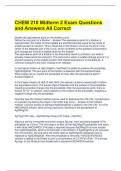
-
CHEM 210 Midterm 2 Exam Questions and Answers All Correct
- Exam (elaborations) • 10 pages • 2024
-
Available in package deal
-
- $8.99
- + learn more
CHEM 210 Midterm 2 Exam Questions and Answers All Correct Identify the equivalence point on the titration curve. Define the end point of a titration. - Answer-The equivalence point of a titration is reached when the moles of titrant added are stoichiometrically equal to the moles of analyte present in solution. This is observed on the titration curve as the point in the center of the steepest part of the curve, which correlates to the greatest concentration (pH) change per volume of add...
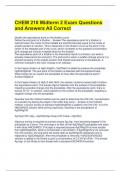
-
CHEM 210 Midterm 2 Exam Questions and Answers All Correct
- Exam (elaborations) • 10 pages • 2024
- Available in package deal
-
- $9.49
- + learn more
CHEM 210 Midterm 2 Exam Questions and Answers All Correct Identify the equivalence point on the titration curve. Define the end point of a titration. - Answer-The equivalence point of a titration is reached when the moles of titrant added are stoichiometrically equal to the moles of analyte present in solution. This is observed on the titration curve as the point in the center of the steepest part of the curve, which correlates to the greatest concentration (pH) change per volume of add...
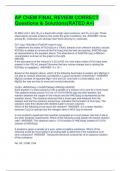
-
AP CHEM FINAL REVIEW CORRECT Questions & Solutions(RATED A+)
- Exam (elaborations) • 11 pages • 2024
-
Available in package deal
-
- $14.99
- + learn more
At 298 k and 1 atm, Br₂ is a liquid with a high vapor pressure, and Cl₂ is a gas. Those observations provide evidence that under the given conditions, the -ANSWER forces among Br₂ molecules are stronger than those among Cl₂ molecules Fe³⁺ (aq) +KSCN(s)->FeSCN²⁺(aq)+K⁺(aq) To determine the moles of Fe3+(aq) in a 100mL sample of an unknown solution, excess KSCN(s) is added to convert all the Fe3+(aq) into the dark red species, FeSCN2+(aq), as represented by the equation abo...
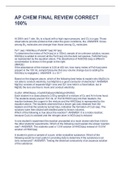
-
AP CHEM FINAL REVIEW CORRECT 100%
- Exam (elaborations) • 11 pages • 2023
-
- $13.49
- + learn more
At 298 k and 1 atm, Br₂ is a liquid with a high vapor pressure, and Cl₂ is a gas. Those observations provide evidence that under the given conditions, the -ANSWER forces among Br₂ molecules are stronger than those among Cl₂ molecules Fe³⁺ (aq) +KSCN(s)->FeSCN²⁺(aq)+K⁺(aq) To determine the moles of Fe3+(aq) in a 100mL sample of an unknown solution, excess KSCN(s) is added to convert all the Fe3+(aq) into the dark red species, FeSCN2+(aq), as represented by the equation abo...
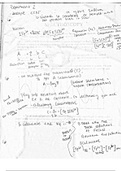
-
Chem 209 Experiment 2
- Summary • 11 pages • 2018
-
- $10.49
- 1x sold
- + learn more
Experiment 2 - Visible Spectroscopy: FeSCN2 and the Determination of SCN- in Human Saliva Inculdes -Experiment 2 Lecture Notes -Quiz Answers for Experiment 2 -Data for Experiment 2 -Calculations for Experiment 2 -Graded Lab Report for Experiment 2

How did he do that? By selling his study resources on Stuvia. Try it yourself! Discover all about earning on Stuvia


